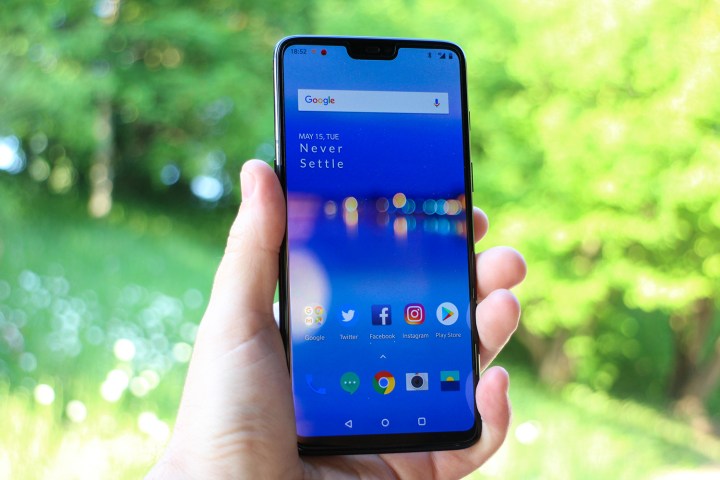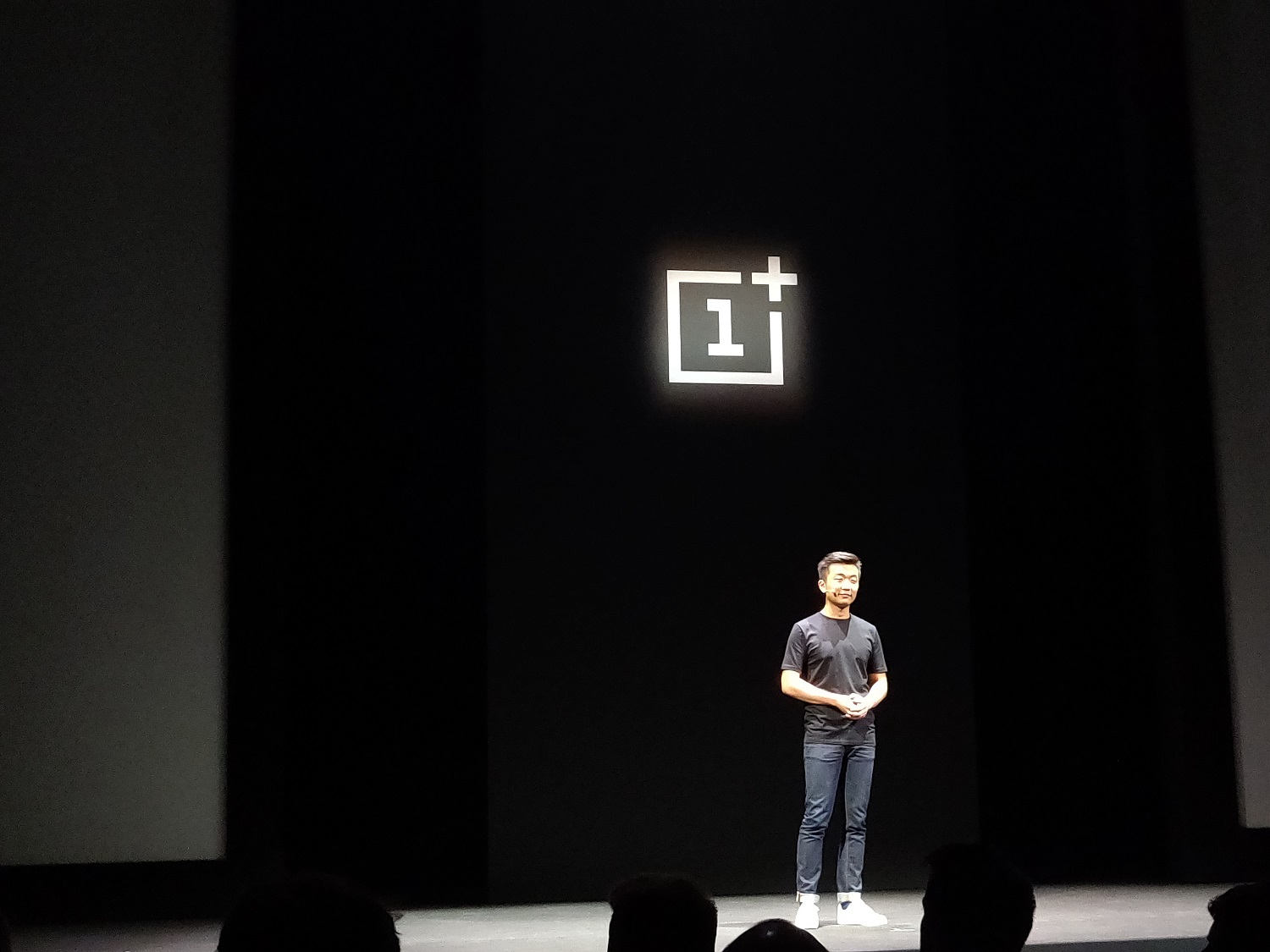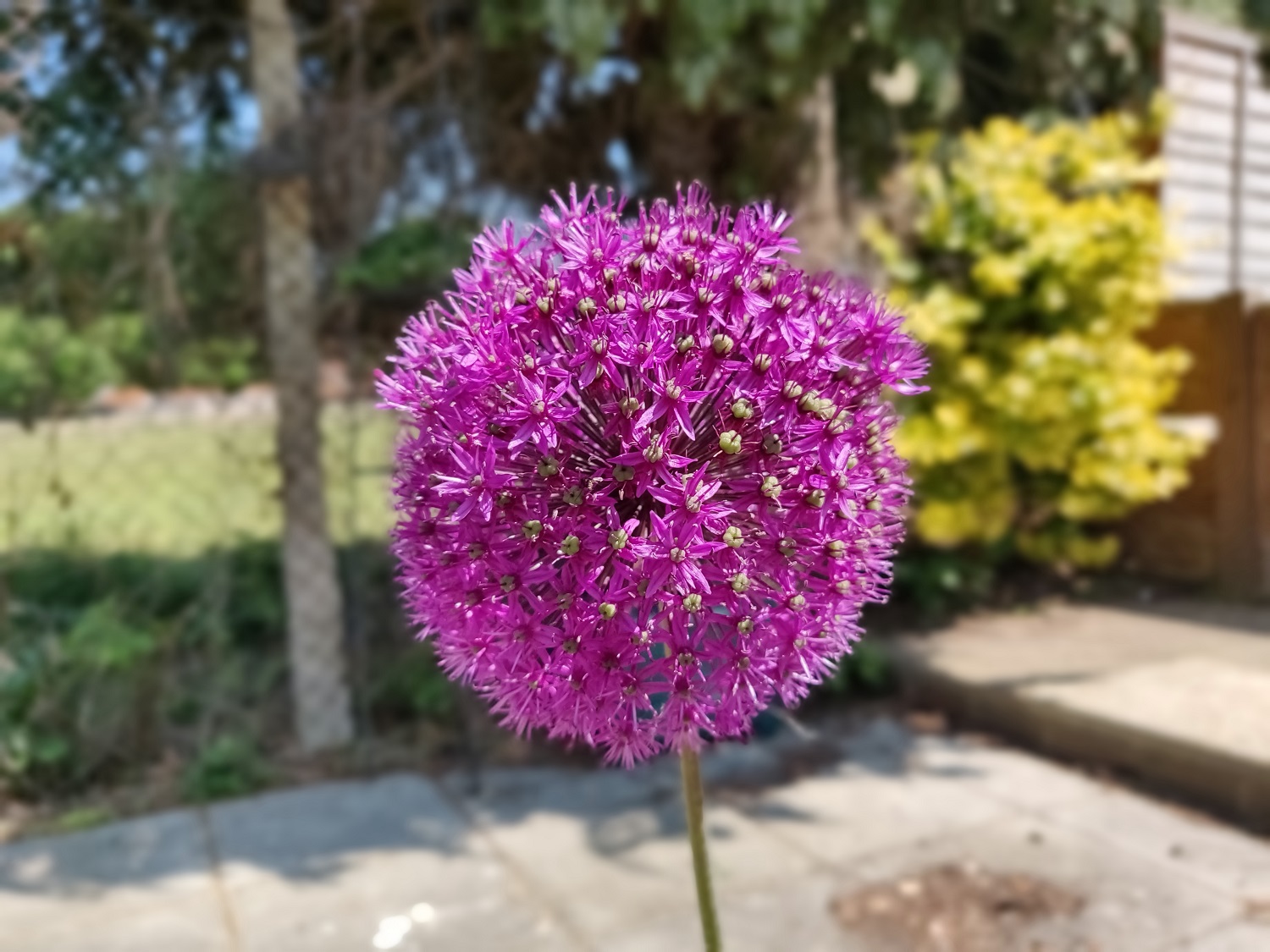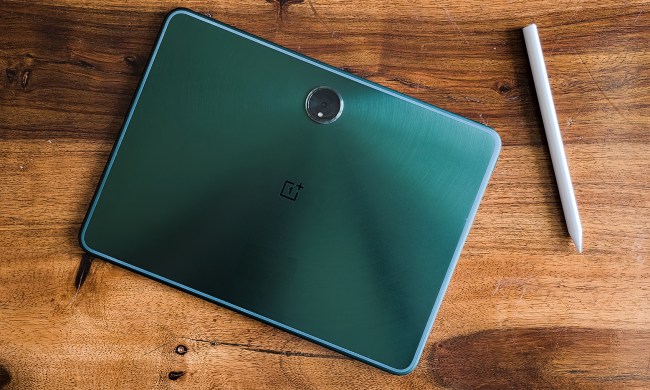- Polished mirror finish looks great
- Massive screen in a compact body
- Super-fast performance
- Speedy charging
- Great price
- No IP-rated water resistance
- No support on Verizon or Sprint
How does OnePlus keep coming up with a desirable smartphone that people will still want to buy, every six months or less? There are companies out there that struggle to do it on an annual basis, after all. OnePlus has a release schedule that would terrify big-name brands bogged down by focus groups, middle managers, and multiple checklists. Its latest phone — the OnePlus 6 — arrives only a few months after the OnePlus 5T, which also came a few months after the OnePlus 5.
It’s a lot of pressure. Can OnePlus continue its winning streak with another swiftly-launched smartphone?
Updated on July 3: We’ve continued to use the OnePlus 6 and have added more insight into the battery, camera, speed, and audio performance. While we continue to be impressed, the score hasn’t changed.
Glassy and classy
The OnePlus 6 showcases how OnePlus is able to attract new buyers and upgraders even with such a rapid update schedule — it taps into the latest trends, integrates them quickly into a new phone, and gets it out the door before any fads pass. That means the OnePlus 6 has a glass body, which is the definition of premium this year, a notch at the top of the screen, and a vertically-mounted, dual-lens camera.
OnePlus has outdone itself with the all-glass body — the second time it has used glass since the OnePlus X. It looks and feels superb: It’s soft and smooth, with a cool touch. It’s very reflective too, mostly on the mirror black model you see here, and we’d say it’s closer to the water-like finish on the Porsche Design Huawei Mate RS than phones like the Honor 10 and the Moto G6. Even the Galaxy S9 looks a bit muddy next to the OnePlus 6. To commemorate its 4th anniversary, the OnePlus 6 brings back the “Designed by OnePlus” branding on the back panel, which is the only other mark aside from the OnePlus logo. It’s minimal, like we have come to expect, and it looks great on the mirror black model.
OnePlus has outdone itself with the all-glass body.
The glass body hasn’t made the phone overly slippery, and it’s easy to hold with one hand. Using it is a harder task due to the size of the screen. It’s a stretch to get to the opposite corner with your thumb.
The notch (the cutout at the top of the screen housing the front camera and earpiece) is the subject of much (now rather boring) controversy. OnePlus told Digital Trends that its inclusion is the most effective way of getting a far larger screen on the phone than usual, while maintaining a similar size to previous OnePlus phones. If you hate the notch, a software setting hides it away.

The screen’s big alright, measuring 6.28-inches with a 2,280 x 1,080 pixel resolution, another first for the OnePlus family. There aren’t too many phones close to this screen size other than the Galaxy Note 8. Surprisingly, the phone is very compact, with minimal side bezels and chin. We like the shape of the screen corners too, which have a flowing curve before running down the sides.
The fingerprint sensor is on the back, and we’re pleased to see it has been given a stadium shape and a chamfered edge: A big improvement over the OnePlus 5T. Little things like this, along with the curved screen edges, make the OnePlus 6 look and feel fantastic.
If you hate the notch, a software setting hides it away.
Another ergonomic improvement is the iconic OnePlus Alert slider, which controls device notifications and silent mode. It has been shifted to the top right edge. While lefties won’t like the change, right-handed folks will find it more comfortable. It’s a bit stiff, and requires a firm grip on the phone to slide, even with the textured edge on the slider itself.
Along the bottom edge of the phone is a USB Type-C port for fast charging, using OnePlus’ Dash Charge system, along with a 3.5mm headphone socket for those still attached to wires. Sadly, there’s no support for wireless charging.
New camera effects, super slow-motion video
On the back is a dual-lens rear camera, this time centrally-and-vertically-mounted inside a slight camera bump. The main f/1.7 aperture, 16-megapixel lens is joined by a second 20-megapixel camera, complete with a portrait mode. New bokeh effects have been added to the portrait mode, adding stars, hearts, and bubbles to the background.
It’s controlled by OnePlus’ own camera app, which is simple and easy to use. OnePlus has added a slow-mo video mode, which has a maximum of 480fps at 720p, meaning it can’t slow the world down as effectively as the Galaxy S9, Huawei P20 Pro, or Sony Xperia XZ2. A 1080p resolution mode is available at 240fps. As you’d expect, this means it’s not quite so dramatic, and shooting at 240fps in 1080p doesn’t make much of a difference. Use the 480fps setting for a better feeling of slow-motion.

You can edit videos in the app, trim the clip down, add music, or a filter. It’s not as wide-ranging as the modes provided by the LG V30, but it’s more than many other phones provide. What’s more is it’s very simple to use. This is key for editing video or stills, and it’s great to see OnePlus implement an edit mode that not only works for video, but for stills too. Yes, you can use apps like Snapseed, but not having to leave the gallery app is a time-saver. The features are also comprehensive.
Taking photos on a sunny London day produced some great shots, with bright blue skies and detail in the shadows. We didn’t see much over-the-top HDR-style glow which has become more common on many devices today. However, a degree of grain is evident in some scenes. The return of optical image stabilization, and the f/1.7 aperture bodes well for low-light photography, and some pictures we took at the phone’s launch — which was in a very dark event space — returned great black levels, and still coping well with the spotlight on OnePlus’s Carl Pei on stage.
In lowlight the OnePlus 6 surprises with its ability. We took several photos in Paris, with plenty of ambient light around, and it brought out some stunning colors, and didn’t miss out on much background detail either, even when zoomed in. It did tend to make the sky a little too blue though. Nit-picking aside, the night photos were definitely ones we would want to share.
The bokeh mode, which doesn’t use a telephoto lens like many other phones resulting in a picture that isn’t cropped, works relatively well. OnePlus has pushed several updates out that address early issues with the performance, and it’s considerably faster now, and quickly recognizes the primary object in the frame before blurring the background. Shooting photos of simple objects, like flowers, demonstrates the OnePlus 6’s ability to capture an object accurately.
Portrait mode has also been added to the selfie camera, although it’s purely software driven due to the single camera lens on the front of the OnePlus 6. The results are acceptable, but not outstanding. For example, it will often blur out the edge of spectacle frames if your head is at an angle. However, this is not a unique problem to the OnePlus 6, and phones including the iPhone X also have difficulty here. When the OnePlus 6 gets the portrait selfie right, the photos look good, although skin tones are lighter than we usually prefer.
Performance
A Snapdragon 845 processor with a whopping 8GB of RAM keeps our test model running, and the OnePlus 6 has been lightning fast in our continued experience. It all feels very refined. OnePlus uses the tagline, “The speed you need,” for the 6, and we cannot imagine anyone thinking the phone may not have the guts to cope with a task. It’s not just marketing either. Everything about the OnePlus 6 is fast, from the face unlock to whizzing around the operating system. Not once did it feel like it was about to get bogged down, or our activities were getting too much. It really has got all the speed you need.
We ran some benchmark tests:
- AnTuTu: 269,191
- Geekbench 4: Single-core: 2,402; multi-core: 8,951
- 3DMark Sling Shot Extreme: 4,586
These scores are very impressive, easily surpassing the OnePlus 5T from last year, plus the Galaxy S9 Plus and LG G7 ThinQ from 2018, which have the same Snapdragon 845 processor. It also exceeds the Huawei P20 Pro, which has the Kirin 970 chip inside. It should be noted the OnePlus 6 may have specially-tuned software to perform well in these tests. This doesn’t detract from its monstrous results.
One notable feature that shouldn’t be ignored is the OnePlus 6’s audio performance. The phone supports AptX HD, which when paired with a pair of compatible headphones and suitable hi-res music tracks, sounds simply fantastic. We’ve been using the phone with the Bowers & Wilkins PX over-ear headphones and streaming music service Tidal, and the results are sublime. While OnePlus’s own Bullets Wireless headphones are good value and sound great, they do not demonstrate what a great music machine the OnePlus 6 can be, provided you spend a little more.
Software and security
Android 8.1 Oreo with version 5.1.8 of OnePlus’s OxygenOS — updated from version 5.1.2 at launch — over the top is smooth and fuss-free, with only a handful of pre-installed apps. There’s also the slide-in Shelf, which contains recently-used apps, contacts, and other information, making it look a little different to standard Android found on a Pixel 2.
Any alterations and special features are all options. A new gesture control system replaces the familiar Android Home, Back, and Menu keys with an iPhone X-like swipe system. It’s not great, and we found swiping on either side of the screen to go back a step frustrating and unreliable. The traditional Android keys may not be pretty, but they work, and that’s what matters.
Face unlock isn’t a substitute for a fingerprint sensor in certain apps.
The fingerprint sensor is under the camera lenses on the back of the phone and is super fast. We’ve had the OnePlus 6 in a case — one of the new official OnePlus cases — and did find it harder to locate accurately due to the amount of recess, so it may be worth checking this for comfort before deciding on a case for the phone. OnePlus’s successful face unlock feature returns, and is reliable and ultra-fast. However, it’s not secure, and isn’t a substitute for a fingerprint sensor in certain apps.
Battery and charging

The OnePlus 6 has a 3,300mAh battery, which we’ve had at least a day’s use out of during our tests. It won’t take us to two days with a single charge, but the phone won’t give up over the course of a long, 15-hour day, meaning a day-and-a-half of sensible use is possible.
What’s certain is that even if you do find yourself short of battery life, the Dash Charge fast charge system tops it up quickly. OnePlus promises a day’s worth of power after 30 minutes on charge, and that’s relatively accurate, although your definition of a day may vary from theirs. With 60 percent charge, the phone would return about six hours with moderately heavy use, including Bluetooth audio streaming and photos. This only works with the included charger and adapter.
Price, warranty, and availability
Has the OnePlus 6 been subject to a price rise that takes it out of the realms of affordability? The price has gone up, but not so drastically you’ll have to think twice. The 8GB/128GB model we’ve been using is $580, or 520 British pounds. A cheaper model with 6GB/64GB storage costs $530 or 470 pounds. Finally, the 256GB version is $630 or 570 pounds and also has 8GB of RAM. The mirror black version seen in our pictures is joined by a midnight black model, along with limited edition silk white and red models, both of which only come in 8GB/128GB configuration for the same price.
In the U.S. OnePlus has a one-year warranty on its devices. In the U.K. this is extended to two-years. Phones with any manufacturing defects will be repaired or replaced free of charge, with shipping and handling costs included. If you damage the phone through mistreatment, or general wear-and-tear, it won’t be covered.
Our Take
The fact OnePlus puts out such a polished product so often is exciting to see. This lightning speed doesn’t affect its quality, or commitment to delivering a satisfying, desirable smartphone.
Is there a better alternative?
An alternative? If you’re set on not spending more than $530 and want something comparable, then no. Price is where OnePlus wins. It’s almost impossible to find the same level of power, style, and ability for the same amount of money. We’re inundated with phones that cost at the minimum $700 ($950-plus isn’t uncommon either), yet the OnePlus 6 manages to squeeze in the key features for several hundred dollars less. It’s closest competitor remains the Honor View 10. And the new Moto Z3 Play is worth a look.
If price is no object, and you just want the best phone for you, then the OnePlus 6 faces tremendous competition, because the standard of smartphones released recently is so high. The Galaxy S9 Plus wins points for its design and camera, the Pixel 2 XL for its software and camera, the Huawei P20 Pro for its best-in-class camera, and the new and relatively reasonably-priced LG G7 ThinQ are all strong alternatives you’ll enjoy owning.
How long will it last?
There is an excellent chance of the OnePlus 6 remaining powerful enough to last for considerably more than two years. OnePlus does support its phones with regular software updates too, plus it’s one of the phones on Google’s Android P beta list, so you can even try out the very latest version of Android when you buy it.
Inside the box is a basic case, so you can protect the beautiful finish and keep it safe in the event of a short drop, plus the body has basic splash proofing. It won’t survive a bath, but it can be used in the rain and won’t wince at the hint of a wet table.
Should you buy it?
Yes, of course you should buy the OnePlus 6, it’s a no-brainer. The price has risen again, but it’s still cheaper than any other high-end phone out there. It doesn’t sacrifice what matters — speed, build quality, design, and features you want to use. If that’s not a reason to hand over your cash, we don’t know what is.




















